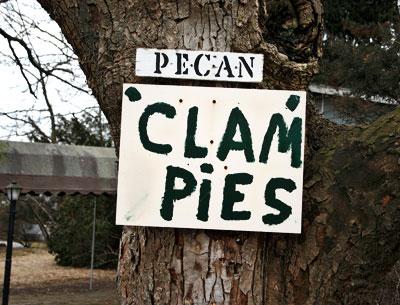Clam Pies Not a Biz

The sale of clam pies isn’t enough to establish the necessary pre-existing, nonconforming status needed to allow a Pantigo Road building located in a residential zone to operate as a business, according to East Hampton Town’s head building inspector and, in all probability, the zoning board of appeals as well, judging by a public hearing held on Tuesday.
On June 11, Tom Preiato, the head inspector since 2009, did initially issue a certificate of occupancy for the former Crystal Room at 250 Pantigo Road, identifying it as having been used continuously as a business since before the town zoning code took effect in the late ’50s.
But a neighbor, Thomas Breen, challenged that action. The house had once been a restaurant, he agreed, but argued that when that use was abandoned, it reverted to residential use only. Mr. Breen filed an appeal to the zoning board in August.
Between then and Tuesday night’s hearing, Mr. Preiato revisited the property and changed his mind about its status.
“It was the old Crystal Room, for those of you old enough to remember,” Alex Walter, the Z.B.A. chairman, said at the start of the evening. “It used to be a restaurant, then it was abandoned for a long time. They sold pies there.”
A wooden sign reading “Clam Pies” hung for years on a tree outside the house.
Mr. Preiato explained his thinking to the board. “Originally, I was contacted by the attorney representing the property, Ralph Esposito. He inquired what would be required to obtain a C of O — he was seeking to continue the use of the property as a restaurant. To me, that use was abandoned.”
Next they looked at the possibility of a retail use. Mr. Esposito pointed out, said Mr. Preiato, that pies had been sold from the house, and provided Mr. Preiato with documentation, which he accepted, and issued the certificate.
But after further research, said Mr. Preiato, “I realized that one nonconforming use [had been] replaced with another.” By documenting the sale of pies, he explained, Mr. Esposito had in fact proven that the original nonresidential use had been abandoned.
“He basically proved my case by saying there was this pie business,” the building inspector told the board. “I am going with the facts that I know. I feel the C of O should revert back [to residential use].”
David Eagan, Mr. Breen’s attorney, agreed. “If you have a pre-existing, non-conforming use, you can only convert it to a conforming use,” he said.
In the end, the question appeared to be moot. Mr. Walter read a letter into the record from Mr. Esposito, in which he told the board that his clients did not wish to pursue the matter further.
Also on Tuesday, the board handed down two decisions. In the first, they approved unanimously, after brief deliberations, the variances requested by John and Anne Albright that will allow them to tear down their house at 5 Jacqueline Drive in Beach Hampton and replace it with a new one, of 2,700 square feet.
The second decision proved more contentious. Nejma Beard, the wife of the photographer and naturalist Peter Beard, applied to the board for variances needed to install a 55-by-10-foot solar panel at the edge of their property, on a bluff near Deep Hollow Ranch in Montauk. While the board praised the applicant’s desire to go green, members were less sanguine about the requested variances.
Bryan Gosman, Don Cirillo, and Mr. Walter had all walked around the property, and all three questioned the proposed location of the panels, only one foot from the property line instead of the code-required 15 feet.
“I saw the stakes,” said Mr. Walter. “I’m not a professional for placing solar panels, but from my layman’s eye I don’t see [why they can’t move it].”
Mr. Cirillo, usually a strong supporter of landowners’ rights, bristled at the request. “It is an excessive variance,” he said. “It is not a constrained property.” Solar panels, he added, should be held to the same standard as any other structure.
Mr. Gosman remarked on the unique qualities of the 63,000-square-foot property, noting that the neighbor most adversely affected by the proposed panels was seldom-used parkland, but concluded nevertheless that the panels could be placed elsewhere. In the end, Sharon McCobb joined the majority, and the board voted 4-1 against allowing the requested variances. Only Lee White, who was voting in absentia, approved.
The Z.B.A. held three other hearings that evening, on Pantelis Karoussos’s request to allow a shed to remain on his Miller Lane East property in East Hampton; on a request from Anthony Michaels to use part of a town right-of-way for eight parking spaces at a new business to be built at South Elmwood Road in Montauk, and on a request from 7-Eleven in Montauk to be allowed to put in curbing and build an enclosed area for a Dumpster.
There was no opposition to the first two proposals. Jeremy Samuelson, the executive director of Concerned Citizens of Montauk, did question the setup of the septic system at the 7-Eleven, which sits on Montauk Highway off Fort Pond.
